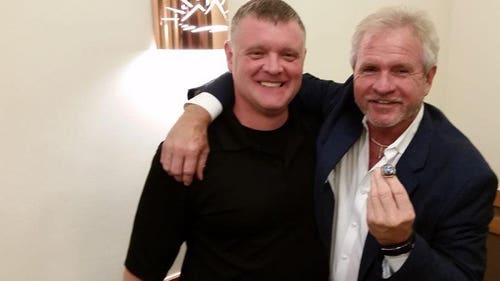
Shohei Ohtani's MVP season will go down as one of the most historic years in MLB history
By Ben Verlander
FOX Sports MLB Analyst
When it came Thursday, the news was a bit of a foregone conclusion: Shohei Ohtani was named the 2021 American League Most Valuable Player, becoming the 19th unanimous MVP in major-league history.
For anyone who witnessed Ohtani's brilliance at the plate and as a dominant starting pitcher for the Los Angeles Angels, the choice was abundantly clear, and that's why the two-way star captured all 30 first-place votes.
For me, Ohtani's season fulfilled the promise that I saw way back in spring training, which prompted me to predict in mid-March that an MVP season could be within his grasp.
But while the brilliance of his MVP campaign is clearly evident now, it's important to remember the challenges Ohtani faced coming off a disastrous 2020 season and the moments when it appeared that his quest to be a two-way star was over.
How did we get here? Why did I predict a special season in March? And why did I become so enamored with him?
Well, good questions.
Let’s get to it.
Ben Verlander reacts to Shohei Ohtani winning the 2021 AL MVP award — Flippin' Bats
In 2018, Ohtani came to the United States from the Hokkaido Nippon-Ham Fighters, with whom he played professionally for five years as a two-way superstar. He was dominant as a hitter and pitcher in Japan, but how would that translate to the game's highest level?
As a rookie in 2018, Ohtani burst onto the scene and won the American League Jackie Robinson Rookie of the Year Award.
From the start, he showed an uncommon combination of power, average and speed — hitting .286 with 22 home runs and 10 stolen bases in just 104 games.
On the mound, he went 4-2 with a 3.31 ERA in 10 starts and struck out 63 batters in 51.2 innings pitched. He was touching 100 mph on the radar gun and featuring a slider that left many hitters scratching their heads.
After that stellar debut season, Ohtani underwent Tommy John surgery, which limited him to DH duties in 2019. No pitching whatsoever.
As only a hitter, however, Ohtani had another strong season offensively. In 106 games, he hit .286 with 18 homers, 62 RBIs and 12 stolen bases.
Then came 2020.
Quite simply, 2020 was an awful year for Ohtani.
Again plagued by injuries, he attempted to pitch and clearly wasn’t the same pitcher as before Tommy John surgery. He started just two games and then shut it down on the mound for the rest of the season.
Offensively, he wasn’t good, either. Perhaps it was all affecting him. The losing, the injuries, the struggles — it all piled up.
In the worst season of his professional career, Ohtani hit .190 in 44 games, striking out 50 times in 175 plate appearance.
Then came 2021. He was finally healthy, and there were signs in the spring that something special was coming from Shohei Ohtani.
That led me to make my March prediction, and it didn’t take long for the two-way phenom to showcase everything I imagined and more.
It started April 4, Ohtani Day.
For the first time in his MLB career, Ohtani pitched and hit in the same game — marking the first time in 118 years that a pitcher was batting in the top two spots in the lineup.
He pitched great. He was throwing hard. And, of course, he hit a bomb.
On April 26, Ohtani became the first pitcher since Babe Ruth to start a game on the mound while leading the league in home runs. When you're doing something that hasn't been done since the Great Bambino, it's pretty historic.
From there, the comparisons to the Babe became a theme of the season.
But Ohtani was not only doing things done by only the most famous baseball player in history. He was also doing them better.
He would pitch. He would hit a mammoth home run. And then, when he had thrown enough pitches, sometimes he would go out into the field and play defense.
On July 7, Ohtani hit his 32nd home run of the season and passed Hideki Matsui for most homers in a single season by a Japanese born player.
It was still the first half!
Not long after he broke that record, Ohtani achieved another milestone when he was named an All-Star as both a pitcher and a batter.
Kevin Cash, manager of the American League All-Star team, chose Ohtani as the starting pitcher for the Midsummer Classic.
Ohtani also participated in the Home Run Derby, becoming the dominant storyline in Denver and overshadowing the biggest stars of the game.
He did the Home Run Derby, he started the All-Star game on the mound, and he led off the game. Incredible.
Ben Verlander revisits the time he met Shohei Ohtani during All-Star week — Flippin' Bats
That historic All-Star Game will never be forgotten because of the impact Shohei Ohtani had.
In the second half, things slowed down for Ohtani because teams stopped pitching to him altogether.
Due to the season-ending injury to Mike Trout, as well as some notable other injuries for the Angels, Ohtani didn’t have much protection in the lineup. He was the one guy in the lineup that you can’t let beat you … and teams didn’t.
Despite not getting pitched to much, Ohtani finished with 46 homers, an OPS of .965 and 100 RBIs. Because of his unique combination of speed and power, he led the league in triples with eight and stole 26 bases.
Want a number that epitomizes how good Ohtani was as a dominant hitter and shut-down pitcher? In 130.1 innings, he allowed just 46 earned runs — the same number of homers (46) he hit at the plate.
What we witnessed from Ohtani was one of the greatest seasons in the history of Major League Baseball.
Ben Verlander recaps the top 10 records Shohei Ohtani broke this season ' Flippin Bats
So what was it about him? Why did I care so much?
Well, the easy answer is because he is one of the most likable players on the planet and is extremely good at the game of baseball — and that is extremely good for the game I love the most.
The long answer? Well, for that, I need to take a look back at my baseball career.
My whole life, I played baseball and was a two-way player. Granted, that isn't uncommon at the youth levels, all the way up to the high-school game.
My career led me to a place where I began to get college offers, and the most important factor for me was choosing a school that would allow me to both pitch and hit at the college level.
I ended up signing as a two-way player at Old Dominion University.
When I got to the Division I level, I quickly realized how difficult playing both ways would be, especially with how hard everyone is working at the Division I level.
I worked and worked and worked, though.
My freshman year, I got into games only as a pitcher, and I had a 4.83 ERA for the season.
As a sophomore, I was able to do both in games for the first time. On the mound, I posted an 8.83 ERA. At the plate, I hit .311 in minimal at-bats.
After two years of college baseball and working as hard as possible to be a two-way performer, it appeared that I was a very average baseball player.
I didn’t want to be average.
So after my first two seasons, I decided to stop trying to pursue the two-way dream and become a hitter. I had shown some promise at the plate my sophomore year, so that choice made sense.
As a junior, while focusing all of my attention on hitting, I hit .367 with 11 home runs and was named a Division I All-American outfielder. I was drafted in the 14th round of the MLB Draft.
It was clear that once I was able to focus all of my attention on one thing, I was able to flourish in that area.
At that time, I would have told you that being a two-way player at a high level was, in a word, impossible.
Then came Shohei Ohtani.
I know the hard work he is putting in behind the scenes. I know how difficult it is to do what he is doing on the field.
I couldn’t do it at the college level. He’s doing this at the MLB level.
That is special, and my appreciation for his achievements couldn’t be higher. (That said, I’m certainly not comparing myself to Ohtani. He has more talent in his pinkie than I have in my entire body.)
Still, though, I know how hard it is to do what he is doing.
What we saw from him changed baseball forever.
He gave kids hope — hope that perhaps one day they, too, can both hit and pitch at the big-league level. He proved that it’s not easy, but it is possible.
We just witnessed the greatest season in the history of Major League Baseball.
Ben Verlander is an MLB Analyst for FOX Sports and the host of the "Flippin' Bats" podcast. Born and raised in Richmond, Virginia, Verlander was an All-American at Old Dominion University before he joined his brother, Justin, in Detroit as a 14th-round pick of the Tigers in 2013. He spent five years in the Tigers organization. Follow him on Twitter @Verly32.








